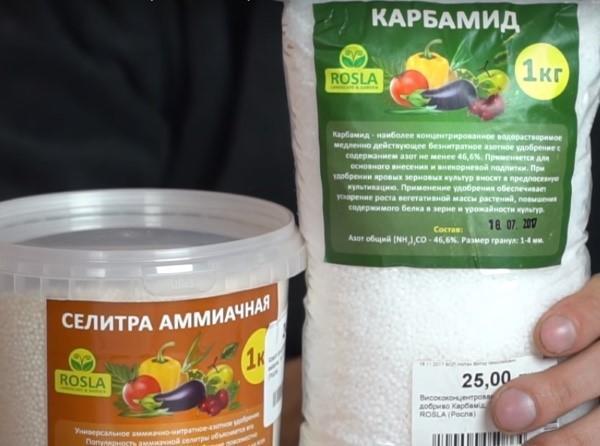Carbamide and saltpeter: finding out which fertilizer is better
 All plants need nitrogen fertilization, especially at the initial stage of development. Some of the most popular nitrogen-containing preparations are carbamide and nitrate. What is better to use for feeding garden and vegetable crops? Today we will take a closer look at this issue, and also find out if there is a difference between fertilizers, and which one.
All plants need nitrogen fertilization, especially at the initial stage of development. Some of the most popular nitrogen-containing preparations are carbamide and nitrate. What is better to use for feeding garden and vegetable crops? Today we will take a closer look at this issue, and also find out if there is a difference between fertilizers, and which one.
What is urea
Urea is the most nitrogen-rich fertilizer. The content of the specified mineral in it is up to 46%. The drug has the form of white rounded granules. This is a compound that can be absorbed by plants, both in direct form and in decomposition.
The drug is also known as urea. So if you meet her in the store, you can safely buy.
Urea can be used for:
- Foliar and root dressing. In a bucket of water, 30-50 g of carbamide is dissolved and the crops are watered under the root or fed on a leaf. Pure granules are introduced directly into the soil in small quantities (up to 15 g per 1 sq. M.).
- Disinfection. In early spring trees and shrubs sprayed on dormant kidneys with a solution of 500 g of the drug per 10 liters of water. This can kill the causative agents of many fungal diseases.
Urea is better absorbed by plants at high temperatures, especially when applied to the soil. It decomposes faster if heat, respectively, begins to feed crops earlier.
When using carbamide for top dressing in the spring, it must be applied at least 3 weeks before it is needed. In summer, there are no such nuances, and you can apply fertilizer right away, it will quickly start working. However, you should carefully dose the drug. Excessive dose of carbamide in solution can cause increased growth of the aerial part to the detriment of fruiting.
Saltpeter - what is it
First of all, it should be noted that in this case, ammonium nitrate is meant as nitrogen fertilizer. It is the second nitrogen-containing preparation after carbamide, ammonium salt and nitric acid. It is also produced in granular form.
The amount of nitrogen is slightly less - maximum 34%. But it is presented in two forms:
- Nitrate.
- Ammonium.
Outwardly, both drugs are very similar. They can be distinguished by their color: in nitrate, the granules have a yellow tint, while in urea they are snow-white.
Saltpeter is very easily and quickly absorbed by plants, and at lower temperatures. This should be taken into account, because if you fertilize on a leaf, you can cause burns. It is better to fertilize with nitrate in the spring or if you need to cause a quick effect, applying at the root (up to 15 g per square of area). It can also be used in watering solutions, but in small doses. But you should not spray, so as not to harm.
Urea and saltpeter - which is better
Having studied the characteristics of fertilizers, we can conclude that both are good, but each has its own nuances of use. For foliar feeding, it is better to use urea. By the content of nutrients, urea is 3 times higher than nitrate. It acts softer, does not burn the leaves. In addition, such dressings can be used throughout the growing season.
The main difference between fertilizers is that carbamide is an organic compound, while nitrate is a mineral one.
Saltpeter is introduced mainly into the soil and it does not depend on temperature. But it also affects the acidity level. If it is elevated, it is better to use urea.By the way, it is easier to store the latter, but for saltpeter, as an explosive substance, special conditions are needed.